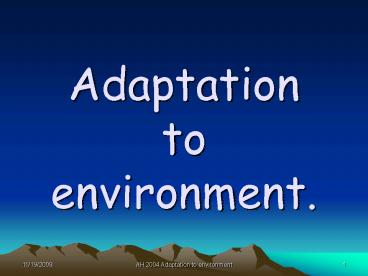Adaptation to environment' - PowerPoint PPT Presentation
1 / 16
Title:
Adaptation to environment'
Description:
To describe how adaptations allow animals and plants to survive in particular environments. ... Hair (short, thick and dense protects skin from sunburn) ... – PowerPoint PPT presentation
Number of Views:1486
Avg rating:3.0/5.0
Title: Adaptation to environment'
1
Adaptationtoenvironment.
2
Adaptation to environment
- Lesson objectives
- To describe how adaptations allow animals and
plants to survive in particular environments.
3
Adaptation to environment
- Adaptation is the development of special
characteristics by plants or animals to suit a
particular environment. - Animals and plants evolve to suit their
environment to increase their chance of survival.
4
Adaptation to environment
- Mammals are adapted in various ways
- They have hairy skin to keep them warm. Hair
traps a layer of air, which insulates the body,
reducing heat loss. - The hair may also be coloured to give camouflage
from predators or prey. - If they live in a cold environment they may have
small external ears to reduce heat loss by
radiation. In warm climates, ear size is often
larger to increase radiated heat loss.
5
Adaptation to environment
- Mammals are adapted in various ways
- Give birth to a small number of well developed
young, which they feed on milk. This increases
the chance of survival. - Lungs which have a large surface area for gas
exchange. - Can maintain a high body temperature, allowing
survival in changing environments.
6
Adaptation to environment
- Fish are adapted in various ways
- Gills to breathe. Gills allow fish to remove
oxygen from the water and to release carbo
dioxide into the water from the blood. - Streamlined body.
- mucous-covered scaly skin.
- Overlapping scales.
- These all help reduce drag (friction) as the fish
swims. - Lay many eggs into the water. This compensates
for heavy losses to predators.
7
Adaptation to environment
- Plants are adapted in various ways
- Extensive root systems to absorb water from deep
underground. - Reduced leaf size, often merely spikes, to reduce
water loss due to transpiration. - Waxy cuticle on their leaves. This also helps
reduce water loss through transpiration.
8
Adaptation to environment
- How are the following species adapted to their
environment. - Think about
- the environment they live.
- What features allow them to survive in that
environment.
9
Adaptation to environment
- Environment Extreme cold, snow and ice.
- Adaptations
- Feed their young (better chance of survival)
- Small ears (reduce heat loss)
- Thick layer of fur (warmth)
- White fur (camouflage) Wide feet (for support on
soft snow) - Sharp teeth (eat prey)
Polar Bear
10
Adaptation to environment
- Environment desert and arid (dry).
- Adaptations
- Can survive up to 8 days without water.
- Broad, soft feet (support on soft sand)
- Humps contain fat (energy store)
- Diet (thorny plants, seeds, dry leaves, bones)
- Hair (short, thick and dense protects skin
from sunburn) - Long eyelashes (protect eyes from sand)
Camel
11
Adaptation to environment
Fish
- Environment water Adaptations
- Gills (remove oxygen from water and release
carbon dioxide from the blood) - Streamlined shape (reduces drag when swimming)
- Mucus covered scales (reduces drag when
swimming) - Large number eggs produced (increase survival as
many eaten by predators.
12
Adaptation to environment
How are Flounders specially adapted to their
environment.
- Environment water.
- Adaptations
- Flat (aid ability to hide from predators)
- Colour (camouflage)
13
Adaptation to environment
How are Sharks specially adapted to their
environment.
- Environment water.
- Adaptations
- Sharp teeth (to rip prey apart).
- Can survive for a long time without food.
14
Adaptation to environment
Cactus
- Environment desert and arid (dry).
- Adaptations
- Small leaves, spikes (to reduce water loss
through transpiration). - Waxy cuticle on leaves (to reduce water loss
through transpiration). - Extensive roots (to absorb water from deep
underground).
15
Adaptation to environment
How are weeds specially adapted to their
environment.
- Environment Wet, pathways.
- Adaptations
- Strong roots (to prevent removal)
- Flat leaves (to prevent removal)
16
Adaptation to environment
- The End.











![⚡Read✔[PDF] Aging in Place: Designing, Adapting, and Enhancing the Home Environment PowerPoint PPT Presentation](https://s3.amazonaws.com/images.powershow.com/10046689.th0.jpg?_=20240603058)



















